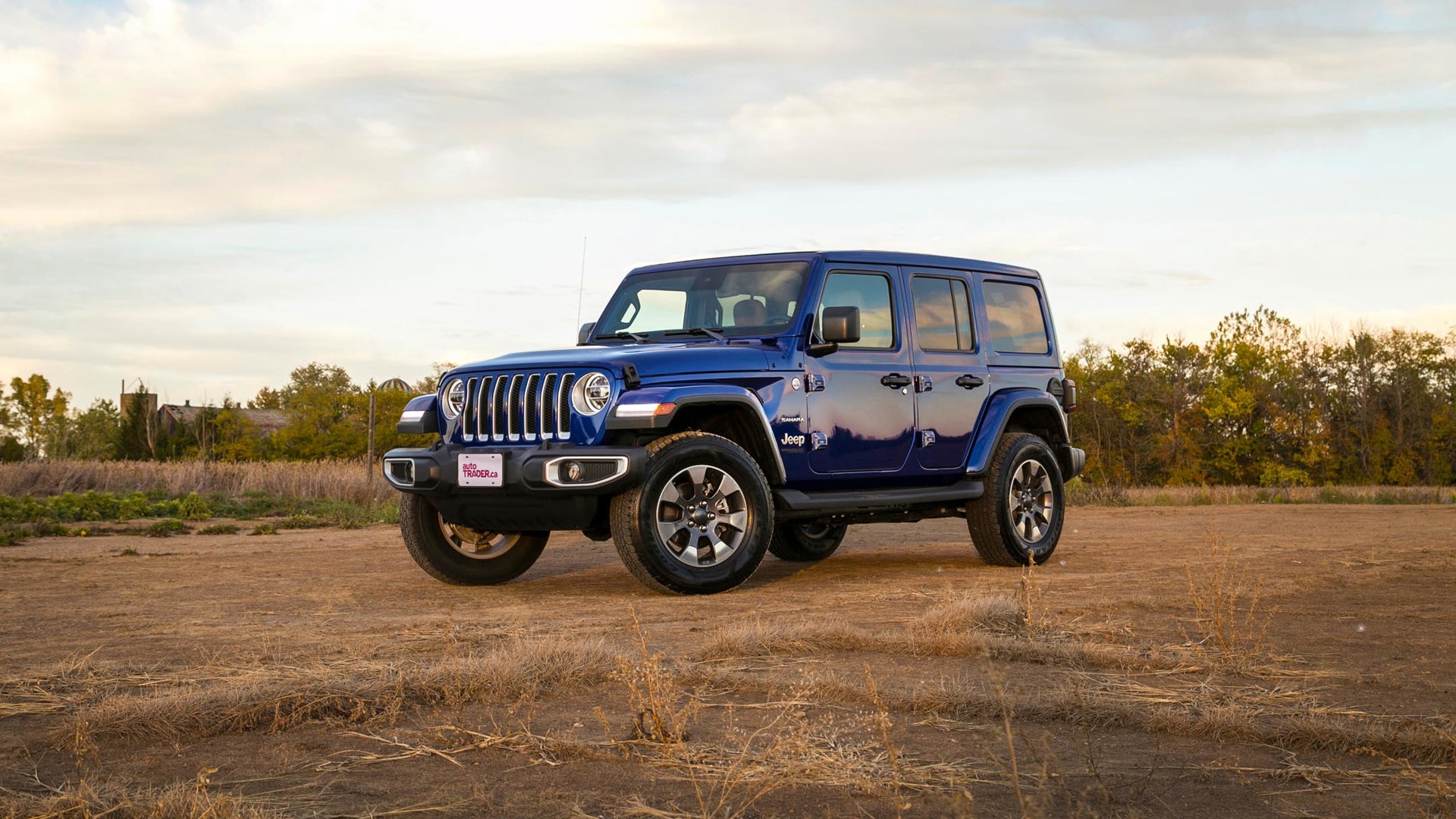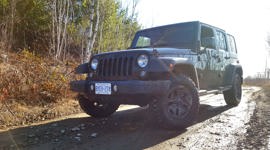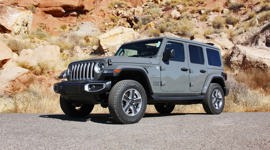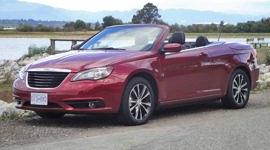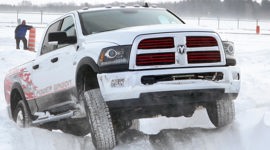 AutoTrader SCORE
AutoTrader SCORE
-
STYLING9/10
-
Safety5/10
-
PRACTICALITY7/10
-
USER-FRIENDLINESS9/10
-
FEATURES7/10
-
POWER9/10
-
COMFORT7/10
-
DRIVING FEEL6/10
-
FUEL ECONOMY6/10
-
VALUE7/10
If there ever was an answer to a question the auto industry never asked it would be mild hybridization.
Dubbed eTorque in the land of Mopar, the technology does nothing to boost acceleration and barely reduces fuel consumption. Yet there’s no denying the noticeable improvement in powertrain refinement provided by the 48-volt electrical system in the 2020 Jeep Wrangler eTorque. Whether it’s worth paying for, however, isn’t quite as clear.
Power: 9/10
Count your humble author among those still pining after the 4.0L that powered Jeeps of old. If ever there was an engine worthy of revival it would be the straight-six that powered the Wrangler for 25 years, providing tons of silky-smooth torque in a bulletproof package. Having once owned a 4.0L-powered Jeep Cherokee, I know firsthand how impressive that engine truly is. Alas, it was shelved long ago, unable to keep up with ever-modernizing emissions standards.
To give credit where it’s due, the 3.6L V6 that ultimately replaced it has proven itself worthy over the years, with even-keeled output that comes in handy both on- and off-road. Naturally aspirated just like its 4.0L forebear, the six-cylinder generates 285 hp and 260 lb-ft of torque – somewhat underwhelming on paper but more than adequate in practice. The torque curve is broad, with near-peak levels across the rev range for the kind of responsiveness that’s as useful when hurdling obstacles as it is passing on the highway.
For better or for worse, the Wrangler’s mild hybrid system does nothing to change that. Instead, it uses a belt-driven electric motor in place of a conventional alternator that feeds a small 48-volt battery pack. By sending electrified jolts to the gas engine, the system reduces the kind of harshness we’ve all grown accustomed to from our engines over the years.
Given how refined the engine and eight-speed gearbox pairing is without the electrical assist, it’s easy to dismiss the mild hybrid system as unnecessary. The improvements are hard to ignore, however, with the slight powertrain imperfections that exist without it all but eliminated.
Engine restarts, which are generally pretty jarring, are noticeably smoother with eTorque along for the ride, while shifts from the eight-speed automatic – the only transmission offered with the mild hybrid system – feel more polished. All this is accomplished by the electric motor sending pulses of up to 90 lb-ft of torque to the crankshaft, reducing unwanted vibrations in the process.
Fuel Economy: 6/10
Gear changes are the biggest benefactors of the eTorque system, being smoothed out to the point of being barely noticed. While the engine’s speed still falls during upshifts just like it would without the 48-volt system, only those with eyes on the tachometer will notice the eight-speed at work. Translation: don’t expect much in terms of noticeable fuel savings.
Yes, eTorque is a mild hybrid system, but any reduction in fuel consumption is negligible at best. According to Natural Resources Canada (NRCan), the two-door Wrangler motivated by the 3.6L engine and automatic transmission pairing should consume a combined 11.8 L/100 km; that figure’s supposed to drop to 11.0 L/100 km with the addition of eTorque.
In reality, getting anywhere close to that is a near impossibility – especially when the Wrangler’s done up in Rubicon guise. The meaty tires and upgraded off-road equipment are a literal and figurative drag on fuel economy, joining the Jeep’s Coleman-cooler aerodynamics to create an especially inefficient SUV. A week-long test spanning 645 km – of which the vast majority was spent on the highway (and some time on the trail, too) – resulted in a combined 12.9 L/100 km.
Styling: 9/10
The Wrangler’s upright shape may be a penalty at the pumps, but it’s also what makes it look so unique. The latest version, introduced in 2018, stays true to the design principles that have made this Jeep such an icon, and the two-door version delivers the ultimate old-school style.
Done up in Rubicon trim, the stubby Wrangler looks every bit as rugged as the mechanical bits beneath it – with or without the top on. The flat plastic fenders hide massive 33-inch BFGoodrich KO2 tires, while the subtle contouring in the sheet metal makes all the contrasting bits the focal point. Despite that fact, the teal hue of my tester, which might well be my favourite colour on the market at the moment, worked well with the Rubicon’s red accents to turn heads everywhere I took it.
Inside, the Rubicon adds red accents to the dash and seats, but it remains a rugged space first and foremost. While the attempt over at General Motors (GM) to give its interiors some chunky, utilitarian controls was a swing and miss in my books, Jeep designers nailed the motif here. Dials for HVAC and audio are rubberized and stand out from the rest of the controls on the dash, looking the part of an old-school offroader.
Value: 7/10
Paying the premium required of the mild hybrid system is an interesting proposition for potential buyers. On one hand, given how much every other upgrade costs – want a heated steering wheel and seats? That’ll be an extra $895 – the $700 that eTorque adds to the Wrangler’s price tag isn’t all that bad on its own. But considering it’s only offered with the eight-speed automatic, which is already a $1,795 addition, shelling out even more money doesn’t make much sense given the limited fuel savings and existing refinement of the powertrain.
Looking across the showroom at the Ram 1500 doesn’t make the technology’s cost-benefit analysis any better, with eTorque equipped as standard in the V6-powered pickup. Why the same doesn’t apply to the Wrangler is beyond my comprehension.
Either way, expect to pay a pretty penny for a shiny new Wrangler. While Jeep generally has generous incentives available that shave thousands from the asking price, even the cheapest two-door will set you back close to $40,000 before tax. The four-door Unlimited, meanwhile, is about $4,000 more across the board. The hardcore Rubicon model I tested has a base price of $48,845 before freight, fees, and taxes – expensive, but not unreasonable for such a capable rig. That price includes trail-tackling goodies like locking front and rear differentials, electronic sway-bar disconnects, and an upgraded suspension.
Should you have your heart set on a Wrangler that works for more than just trail duty, Jeep will gladly sell you some options that make it so. While I can’t fathom paying this kind of cash for a vehicle without leather upholstery, it can be had as a $995 upgrade. Then there’s that so-called Cold Weather package, and an upgraded 8.4-inch touchscreen infotainment system that comes with a built-in Wi-Fi hotspot and Apple CarPlay and Android Auto. None of it’s cheap, but it all makes the Wrangler’s cabin a bit more civilized.
Practicality: 7/10
If I’m buying a Jeep Wrangler I’m buying it to use it the way it was intended. And if that’s the case, I’m going straight for this classic two-door. The only trade-off is the limited utility the body style brings with it. For starters, crawling into the back seat is comically difficult, though occupants are rewarded with a surprising amount of space once back there (my tester also offered rear-seat users two USB-A ports, two USB-C ports, and a household outlet). Cargo room, too, is rather limited – though it isn’t difficult to flip the rear bench forward for more space when required.
Features: 7/10
The Wrangler isn’t one to shower occupants with creature comforts and technology – though options in that vein can be added at will. Instead, what you’re paying for is unmatched capability. Even without all the extras of the Rubicon model, the Wrangler can go where few other vehicles can venture. And it can do it all without a roof and doors.
Generous ground clearance, solid axles front and rear, a part-time four-wheel-drive system with high- and low-range gearing, and impressive approach and departure angles make it all but unstoppable off the beaten path. Those with aspirations of four-wheeling with a warranty would do well to shell out for the Rubicon, which takes the rugged Wrangler to the extreme. There are those locking differentials – which keep the left and right wheels spinning at the same rate, useful in low-traction situations – and electronic sway-bar disconnects in the front, allowing for further suspension articulation in extreme settings. The suspension, too, gets upgraded, with hydraulic rebound stops that essentially cushions the shocks at full extension. There’s also a 4.0:1 low-range ratio transfer case, and beefy 33-inch tires.
User Friendliness: 9/10
All that stuff makes even the most challenging trails feel like child’s play. With 274 mm (10.8 inches) of ground clearance and a 44-degree approach angle, even large obstacles like rocks and downed trees are easy to overcome without much fuss. That, too, is where the two-door’s short wheelbase comes in handy, with its 27.8-degree breakover angle keeping it from getting hung up and high-centring when hurdling objects on the trail.
The trail I traversed during testing provided a nice mix of terrain – rock, loose stone and dirt, and thick mud – spread across steep hill climbs and steady descents. Yet none of it required anything more than the four-wheel high setting on the transfer case and the precautionary disconnection of the front sway-bar for better suspension travel. Dropping the wheels in deep ruts was unnerving only to my passenger, with the Wrangler leaning on its low-end torque to crawl out with barely more than a tap of the throttle pedal.
From behind the wheel, every feature a driver needs to access when negotiating a trail is easily accessible, too. From the mechanical transfer case lever located next to the shifter to the switchgear for the sway-bar and differentials, never does the Wrangler leave you hunting for a required function in a high-stress situation. There’s a certain man-machine simplicity to it that’s been the quintessential Jeep’s hallmark for the better part of eight decades, and it still exists today. There’s no fancy computer-controlled traction management system here – it’s raw mechanical prowess and driver technique that’s required to get the Jeep out of a jam.
Driving Feel: 6/10
That old-school flair is also part of the Wrangler’s on-road behaviour, which can be troubling at times. The electro-mechanical steering rack that’s outstanding on the trail is a chore off it, requiring constant driver input to travel in some semblance of a straight line. The way the Wrangler wanders down the road is exhausting, not to mention a little dangerous. All it takes is a momentary glance at the infotainment screen for the Jeep to drift towards oncoming traffic. If that’s part of the charm of a Jeep then consider me put off.
All these years later, the Wrangler still isn’t ideal for daily use, and this classic setup in particular – two-doors, tiny wheelbase, and chunky tires – is the worst of the bunch. The solid front axle isn’t only responsible for the way it drifts about on the road but also the way it shudders incessantly over uneven surfaces like a hammer drill.
I just can’t imagine dealing with the miserable nature of the Wrangler’s ride quality on a daily basis – especially on the highway, where it’s a constant battle to keep it moving in the intended direction. Add wind to the mix and the boxy Jeep gets pushed around like a recycling bin on a blustery day; definitely not ideal for commuting duty.
Comfort: 7/10
Comfort, too, is sacrificed at the cost of capability, and the Wrangler could well be classified among the worst on the market. In spite of the springy suspension and chunky tires, just about every crack, bump, and manhole cover reverberates through the body and frame, while the nose heaves and dives under acceleration and braking, respectively. Body roll, too, runs precariously close to the limits of my comfort level, with behaviour that’s akin to a barely touched beer sloshing around inside a pint glass; it might not spill over the edge, but it’s all but impossible to shake the feeling it might well do so at a moment’s notice.
Safety: 5/10
While the Wrangler can be fitted with at least a few modern advanced safety features – the one I tested came with blind-spot monitoring, automatic emergency braking, and adaptive cruise control that works in stop-and-go traffic – there are some inherent flaws in its upright design that pose serious safety concerns.
During crash testing by the not-for-profit Insurance Institute for Highway Safety (IIHS), the Wrangler rolled on its side not once but twice. It’s important to point out that this occurred during testing of the four-door model, and the IIHS hasn’t crash-tested the two-door version. The agency also pointed out that the testing dummy was well protected in both Jeeps that tipped over. But it’s disconcerting nonetheless to learn that this popular SUV is prone to rolling in a common crash scenario.
The Verdict
A plug-in hybrid Wrangler’s apparently on its way, but until it arrives I’d probably skip this mild hybrid version and stick with the 3.6L without the electrical assistance (personally, I’d take the manual, too). It’s not that it doesn’t add even more powertrain refinement – in fact, it’s impressive just how much smoother shifts and engine starts are as a result of the supplementary electric motor. But neither were notable deficiencies to begin with. While fuel consumption is apparently reduced, the real-world savings just aren’t meaningful enough to justify the price bump, and the extra money is better spent in the pages of the Mopar accessories catalogue.
| Engine Displacement | 3.6L |
|---|---|
| Engine Cylinders | V6 |
| Peak Horsepower | 285 hp @ 6,400 rpm |
| Peak Torque | 260 lb-ft @ 4,800 rpm |
| Fuel Economy | 12.0 / 9.8 / 11.0 L/100 km cty/hwy/cmb |
| Cargo Space | 365 / 1,328 L seats down |
| Model Tested | 2020 Jeep Wrangler Rubicon |
| Base Price | $48,845 |
| A/C Tax | $100 |
| Destination Fee | $1,895 |
| Price as Tested | $65,625 |
|
Optional Equipment
$14,785 – Automatic Transmission, $1,795; Advanced Safety Group, $1,450; Uconnect 4 w/Nav & Sound Group, $1,395; Steel Bumper Group, $1,295; Black Freedom Top Hardtop, $1,195; Leather Upholstery, $995; Cold Weather Group, $895; Tow Group, $895; LED Lighting Group, $895; SafetyTec Group, $845; 3.6L V6 w/eTorque, $700; 17-inch Black Aluminum Wheels w/Machined Lip, $695; Hardtop Headliner, $495; Keyless Entry, $300; 17-inch Off-Road Tires, $295; Trail Rated Kit, $250; Trail Cargo Management System, $195; Bikini Pearl Paint, $100; All-Weather Floor Mats, $100
|
|

